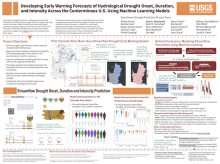Developing Early Warning Forecasts of Hydrological Drought Onset, Duration, and Intensity Across the Conterminous U.S. Using Machine Learning Models
John
Hammond
U.S. Geological Survey
Poster
Drought events will likely be more impactful and widespread in coming years given continued climate change. Hydrological drought, defined as abnormally low streamflows and groundwater levels, has direct impacts on agriculture, hydropower, ecosystems, public water supply, and recreation. Unlike more readily-available precipitation forecasts, forecasting streamflow drought requires accounting for storage (snow and groundwater), human modifications (diversions and reservoirs), and complex terrestrial processes. To address this challenge, the U.S. Geological Survey Water Mission Area Drought Program is working to advance early warning capacity for hydrological drought onset, duration, and severity using data-driven models. We use gradient-boosted decision tree and long short-term memory neural network modeling approaches to forecast 1-13 week streamflow percentiles across the conterminous United States (CONUS) using gridded meteorology and meteorological forecasts, modeled snow and soil moisture, and watershed properties. Forecast uncertainty is provided using quantile regression and probabilistic outputs from classification and survival models. We forecast drought for moderate (20%), severe (10%) and extreme (5%) intensity levels using seasonally varying drought thresholds. Overall, models show a strong ability to forecast severe droughts via variable streamflow percentiles in the near term, with median KGE of 0.87 for 1 week forecasts and 0.69 for 2 week forecasts, and Cohen’s Kappa values of 0.61 and 0.33. Models had weaker predictive capacity for regulated basins, drier areas of the CONUS, increasingly intense droughts, and longer lead times; for these reasons modified approaches are being explored to improve model performance. Initial results show that forecast meteorology improves KGE for 1- and 2- week horizons, and analog forecasting, which compares current weather patterns to similar patterns from the past, boosts Kappa for 1- and 2-week drought duration models. When predicting groundwater drought, initial evaluations show improvement upon persistence models for 3-12 month lead times. As we develop hydrological drought assessment and forecast tools, we are incorporating stakeholder input to design tools that complement existing drought and water supply prediction tools.
Poster PDF

Meeting homepage